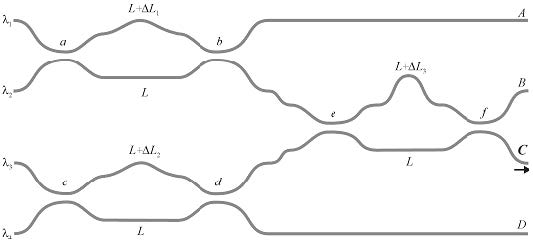Let us consider the well-known basic four-channel Mach-Zehnder multi/demultiplexer [5]. The circuit consists of three different Mach-Zehnder interferometers (MZI) [[1] p. 160], where each MZI has a different arm length. This multiplexer is designed to “collect” the signal of different wavelengths from 1500 nm to 1550 nm introduced from different inputs into the output named C with the channel separation 7.5 nm (for details, see [5]).
Figure 3: Basic four-channel Mach-Zehnder multi/demultiplexer
The device can be fully analyzed by the BPM, however we can show it is not necessary. The distances among the input ports (named with the respect to multiplexed wavelengths) are typically 0.25 mm and the device is several millimeters long, the circuit area is quite large. Note, the speed of the BPM simulator is approximately proportional to the layout area. Further, we can see that the layout is, say, somehow coarse, i.e. we can declare some places where the field exists in the evanescent form and the field is negligible. Running the simulation through these places is inefficient, however we cannot exclude these “dead places” from the rectangular simulation window. Our new approach proposes an elegant solution (see the pertinent paragraph below).


